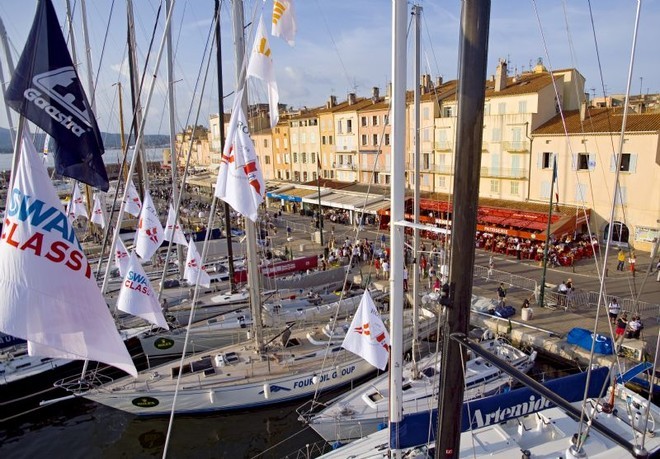Med-mooring- you can't avoid it, so get used to it!
by Des Ryan/Sail-World Cruising on 18 Mar 2013

Dock Side, boats moored in St Tropez after racing Rolex/ Kurt Arrigo
http://www.regattanews.com
Heading to the Mediterranean any time soon? Then you'll need to know how to med-moor! Here is the first version - how to med-moor to a dock or quay, either using your anchor or a lazy line already in place.
[Sorry, this content could not be displayed]
Some Pointers
This scenario is very similar to the majority of bow-to berths at many older berthing situations in New Zealand or Australia. It becomes more complex if you need to deploy your anchor, but having grasped a few concepts, with a bit of practice it becomes second nature.
'Mediterranean mooring is often viewed with trepidation. It looks complicated and if you get it wrong you tend to look silly.'
'As with any manoeuvre it’s all about staying calm, feeling confident and briefing your crew correctly. Getting a manoeuvre like this right is a very satisfying feeling.'
Anchoring stern-to:
• First things first; when anchoring stern-to, there’s unlikely to be any cross-tide, so the wind will be the strongest force. This simplifies matters significantly. If you can gauge where the wind is trying to push you, that’s half the battle already won, and there won’t be any unpleasant surprises.
• You may be backing into quite a narrow space, if so make sure the boat is well fendered prior to starting your approach and set up a stern line off each stern cleat with big loops in the end of each. Having done this, station one crew on the foredeck, ready to let go the anchor.
• Look for any anchor chains leading from the bows of boats already moored and check the direction in which they are pointing to ensure you don’t foul them. It may be sensible to rig a 'tripping line' to your own anchor just-in-case.
• Start your reverse run from a long way off - to establish good flow over the rudder – and thus steering control in reverse, then start to line yourself up with the gap about four boat lengths out.
• At about three boat lengths (depending on the depth of water), have your crew lower the anchor and pay out plenty of slack whilst you reverse in as slowly as you dare without losing steerage - this will depend on how much wind there is.
• A couple of metres off, have your foredeck crew begin to take up the strain on the anchor warp as you ease the boat back towards the harbour or dock wall.
• Have another crew (if you have one) step off with the stern lines and drop the loops over the nearest bollard. Otherwise the skipper will have to double as stern crew, unless there is someone on the wharf to whom you can throw the lines.
(With the cooperation of cruising sailors being magnificent this is often the case, or there might be a marina worker who comes to help. Sometimes when they see an Australian or New Zealand flagged boat approaching, they come out in the dinghy just to make sure you don't damage the other boats. Accept their help gladly before you get the hang of it!)
• Now it’s just a question of tightening everything up and ensuring your anchor has held; you want your stern to be about half a metre off the quay.
Bow first:
Some skippers prefer to carry out the whole manoeuvre with the bow facing towards the quay - providing better steerage. If you have serious prop walk, this is an excellent option. It can be easier to execute if the boat is set up for it; many Med-based boats will have a designated anchor in the cockpit for this purpose. The main problem with mooring bow-to is access to the quay, as clambering over the pulpit can present a challenge to those who are not very flexible.
Lazy lines
Lazy lines can appear confusing, but actually simplify matters by eliminating the need to drop an anchor off the bow. If you see rope rather than anchor chain leading from the bow of other boats, then you know what to expect.
Lazy lines normally, but not always, come in pairs and you will find them attached to the quay at one end. The procedure is much the same as for anchoring stern-to except, very importantly you don’t drop your anchor!
After securing yourself to the quay, find the lazy lines and walk them up to the bow and tension them up. Again, this is a manoeuvre which can be done bows to. Check the lazy lines for any wear and tear once you are moored up.
With this manoeuvre successfully accomplished, all that remains is to head ashore and enjoy that cold beer you were promising yourself, secure in the knowledge that you have proven your boat handling prowess.
This is how to med-moor to a dock or a quay. It's quite different to med-moor to a tree in the middle of a bay which is too deep for anchoring - so that's another story!
Some excerpts and the diagrams have been taken from http://www.rya.org.uk/shop/pages/product.aspx?pid=g68(RYADefaultCatalog)!RYA_Boat_Handling_for_Sail_and_Power by Rob Gibson
If you want to link to this article then please use this URL: www.sail-world.com/107587